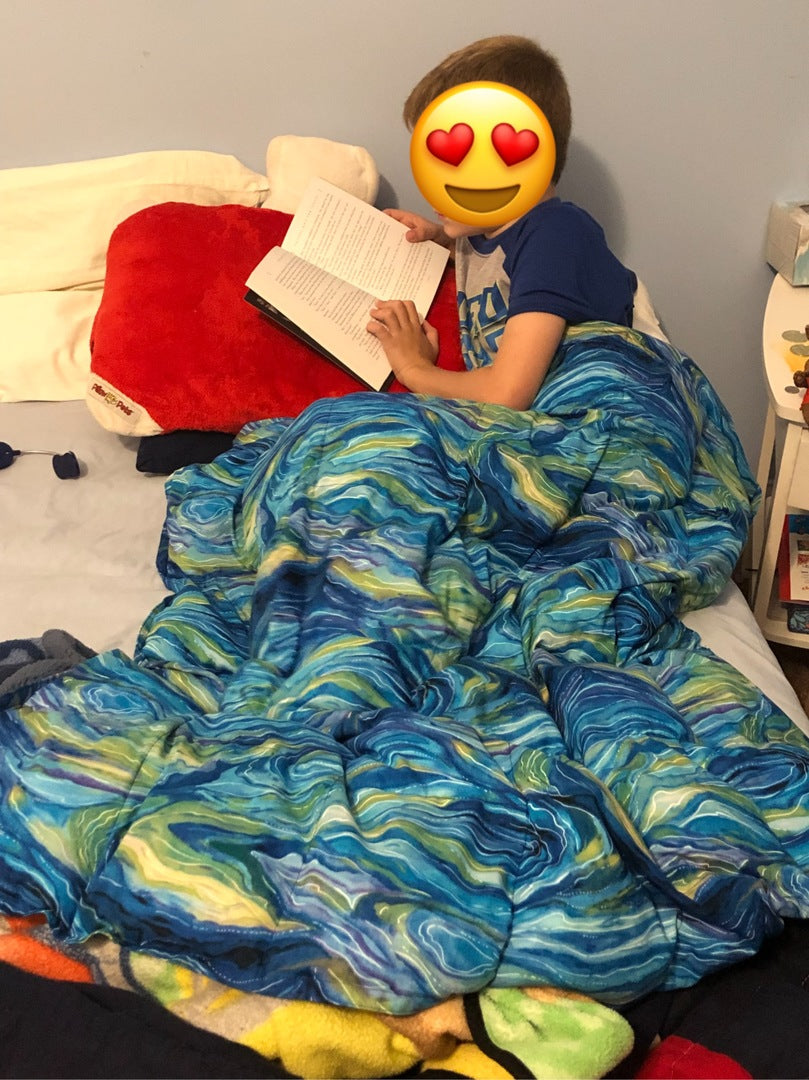Your Cart is Empty
- Save 15% at Checkout
- Free shipping over $199.95 Contiguous U.S.
Your Cart is Empty
November 06, 2021 3 min read
Autism spectrum disorder (ASD) describes five disorders that fall under the category of pervasive developmental disorders, and they include:
Children afflicted with one of thesedisorders typically have problems communicating, engage in repetitive actions or behaviors, lack social skills and show slow cognitive development. Symptoms of ASD can be seen in children as young as 18 months old.
These children and their parents face many challenges each and every day, and while there are several treatments and therapies designed specifically for children with ASD, the Mosaic Weighted Blanket® has been known to be a helpful tool for patients and families impacted by ASD.
When the child is awake, you can lay the weighted blanket across their shoulders or evenly distribute it across their body. Thedeep pressure touch stimulation brought about by the blanket is known to produce serotonin in the child (the happy hormone) while simultaneously reducing cortisol levels (the stress hormone).
At bedtime, cover your little one with the weighted blanket to once again help the production of serotonin, which has been known to also lead to the production of melatonin--the hormone that helps us achieve a peaceful, restful night's sleep.
Autism is a complex disorder, and there is still much research to be done before it's fully understood. The term actually covers a number of disorders on the autism spectrum, and, even within finer categories along that spectrum, autism affects each person differently. Typically, autism is apparent by age two, and changes and/or impairs social development, communication skills, and sensory processing. It is four times more likely to affect boys than girls, but children of all races, classes and social groups can be affected. It can be a very challenging disorder to deal with, both for the people who have it and for their caretakers.
Temple Grandin who was also diagnosed with Autism, is the founder of the science behind Deep Pressure Touch. Grandin was an animal scientist and realized that when Deep Pressure Touch was applied to cows before going through a shoot they became more relaxed and much calmer. Grandin recognized the impact that Deep Pressure Touch had on cows and applied that same concept to people who had extreme anxiety as a symptom of Autism.
Fortunately, weighted blankets may be a tool to help in managing common manifestations of autism spectrum disorders.
Why use weighted blankets for autism? Weighted therapy blankets are known to allow for something calleddeep pressure touch stimulation, which in turn produces serotonin, a neurotransmitter thought to be very influential on mood (as well as appetite, sleep, memory, and learning). Many parents have found that draping a weighted blanket across the lap or shoulders of a child with autism helps him or her to feel more secure and stay calm throughout the day.
Many parents also found that using weighted blankets for autism helps their children with sleep disruption at night. Sleep disturbances are extremely common for people of all ages with autism. These disturbances might includesleep latency (taking more than an hour to fall asleep after the lights are out), getting fewer than seven hours of continuous sleep, or other struggles to get restful sleep. Weighted therapy blankets have been known to help children fall asleep more quickly, stay asleep for longer, and get more restful sleep. This is probably due to a combination of the physical weight of the blanket, which discourages tossing and turning without being too restrictive or warm, and the possible natural production of sleep-related chemicals in the body caused by pressure.
A weighted blanket also offers quite a bit of savings in comparison to other therapies, and carries no side effects. And, even better, weighted blankets are often eligible for reimbursement under insurance plans.
The pandemic has had an enormous impact on all Americans’ sleep habits, but has been especially hard on children with autism who may already be dealing with sleep-related issues. To help children with ASD regain a healthy sleep routine,this guide has actionable methods for coping with stress and sleep disorder during this time.
